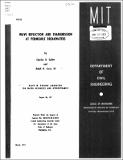| dc.contributor.author | Sollitt, Charles K. | en_US |
| dc.contributor.author | Cross, III, Ralph H. | en_US |
| dc.date.accessioned | 2022-06-13T13:06:01Z | |
| dc.date.available | 2022-06-13T13:06:01Z | |
| dc.date.issued | 1972-03 | |
| dc.identifier | 147 | |
| dc.identifier.uri | https://hdl.handle.net/1721.1/142968 | |
| dc.description.abstract | Rubble mound breakwaters are designed to protect exposed marine areas from excessive wave activity. Observations of breakwaters interacting with surface waves in laboratory models and in full scale field applications demonstrate that significant wave energy is transmitted through the interstices of structures commonly regarded as being impervious. The objective of this investigation is the development of a theoretical analysis to account for this phenomenon. The results are intended for use by coastal engineers to compare the effectiveness of alternative breakwater configurations, independent of repetitive experimental programs. Three breakwater configurations are considered: 1) crib style breakwaters with vertical walls and homogeneous fill, 2) conventional trapezoidal shape breakwaters with layered fill, and 3) pile array breakwaters composed of vertical piles placed in symmetric patterns. The two dimensional problem is studied. Waves are assumed to arrive at normal incidence. The theoretical development begins with the unsteady equations of motion for flow in the voids of an arbitrary porous structure. The equations are linearized using a technique which approximates the known turbulent damping condition inside the structure. This yields a potential flow problem satisfied by an eigen series solution. Linear wave theory is assumed to apply outside the structure and the excitation is provided by a monochromatic incident wave. The reflected, transmitted and internal wave amplitudes are determined by matching the general solutions at the sea-breakwater interfaces and requiring continuity of pressure and horizontal mass flux. Inclusion of sloping face structures necessitates an estimation of the breaking losses incurred on the windward slope. A semi-empirical method, adapted from Miche's work, is used to approximate the effect of wave breaking. An experimental program is conducted to verify the analytical models. Theory and experiment yield the following general conclusions: 1) the transmission coefficient decreases with decreasing wave length, breakwater porosity and permeability, and increasing wave height and breakwater width; 2) the reflection coefficient decreases with increasing wave length, breakwater porosity and permeability, and decreasing breakwater width. Application of the theory is limited to wave heights which exceed the medium grain diameter. Experimental results correlate better with the theoretical transmission coefficient than with the reflection coefficient. This seems to be due to the sensitivity of the reflection coefficient to surface effects. The theory provides useful design estimates for all three breakwater configurations and a full range of wave lengths. The proposed wave breaking calculation gives favorable results for the sloping face structure tested in this study. However, further comparison is needed to establish the general validity of the breaking wave analysis. | en_US |
| dc.publisher | Cambridge, Mass. : Ralph M. Parsons Laboratory for Water Resources and Hydrodynamics, Department of Civil Engineering, Massachusetts Institute of Technology | |
| dc.relation.ispartofseries | R (Massachusetts Institute of Technology. Department of Civil Engineering) ; 72-22. | |
| dc.relation.ispartofseries | Report (Ralph M. Parsons Laboratory for Water Resources and Hydrodynamics) ; 147. | |
| dc.title | Wave Reflection and Transmission at Permeable Breakwaters | en_US |
| dc.identifier.oclc | 1025298 | |
| dc.identifier.aleph | 246559 | |
